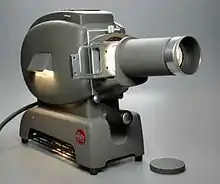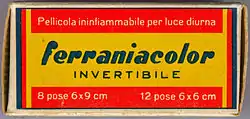Reversal film
In photography, reversal film or slide film is a type of photographic film that produces a positive image on a transparent base. Instead of negatives and prints, reversal film is processed to produce transparencies or diapositives (abbreviated as "diafilm" or "dia" in some languages like German or Hungarian). Reversal film is produced in various sizes, from 35 mm to roll film to 8×10 inch sheet film.


A slide is a specially mounted individual transparency intended for projection onto a screen using a slide projector. This allows the photograph to be viewed by a large audience at once. The most common form is the 35 mm slide, with the image framed in a 2×2 inch cardboard or plastic mount. Some specialized labs produce photographic slides from digital camera images in formats such as JPEG, from computer-generated presentation graphics, and from a wide variety of physical source material such as fingerprints, microscopic sections, paper documents, astronomical images, etc.
Reversal film is sometimes used as motion picture film, mostly in the 16 mm, Super 8 and 8 mm "cine" formats, to yield a positive image on the camera original. This avoids the expense of using negative film, which requires additional film and processing to create a positive film print for projection.
History
Additive method
The earliest practical and commercially successful color photography reversal process was the Lumière Autochrome, introduced in 1907. This was an additive method, using a panchromatic emulsion coated on a thin glass plate previously coated with a layer of dyed potato starch grains. Autochrome plates were discontinued in the 1930s,[1] after the introduction of Lumière Filmcolor in sheet film and Lumicolor in roll film sizes. Also using the additive principle and reversal processing were the Agfa color screen plates and films and Dufaycolor film, all of which were discontinued by 1961.[2]
Subtractive methods
Leopold Godowsky, Jr. and Leopold Mannes, working with the Eastman Kodak Company, developed Kodachrome, the first commercially successful color film to use the subtractive method. Kodachrome was introduced in 1935 as 16mm motion picture film, and in 1936 as 35mm film for still cameras.[3] The Kodachrome films contained no color dye couplers; these were added during processing.
In late 1936, Agfacolor Neu was launched, Agfa having overcome earlier difficulties with color sensitivity problems. This film had the dye couplers incorporated into the emulsion, making processing simpler than for Kodachrome.[2]
Early color negative film had many shortcomings, including the high cost of the film, processing and printing, the mediocre color quality, rapid fading and discoloration of highlights[4] of some types of print that became noticeable after several years. Amateurs who owned projection equipment used reversal films extensively because the cost of projection equipment and slide film was offset by not having to pay for prints. Eventually, print quality improved and prices decreased, and, by the 1970s, color negative film and color prints had largely displaced slides as the primary method of amateur photography.
Until about 1995, color transparency was preferred for publication because of the films' higher contrast and resolution, and was widely used in commercial and advertising photography, reportage, sports, stock and nature photography. Digital media gradually replaced transparency film. [5]
Film types
All color reversal film sold today is developed with the E-6 process. The non-substantive Kodachrome films, the last of which was discontinued in 2009, were processed with the K-14 process.[6]
Polaroid produced an instant slide film called Polachrome. It was packaged in cassettes like normal 35mm film. A separate processing unit was used to develop it after exposure.
Black and white
.jpeg.webp)
Black-and-white transparencies can be made directly with some modern black-and-white films, which normally yield negatives. The negative image is developed but not fixed. The negative image is removed by bleaching with a solution of potassium permanganate or potassium dichromate in dilute sulfuric acid, which is removed by washing and a clearing bath containing sodium metabisulfite or potassium metabisulfite. The remaining silver halide salts are re-exposed to light, developed and fixed, and the film is washed and dried.[7]
Black-and-white transparencies were once popular for presentation of lecture materials using 3¼"×4" (3¼" square in the UK) glass-mounted slides. Such positive black-and-white projection is now rarely done, except in motion pictures. Even where black-and-white positives are currently used, the process to create them typically uses an internegative with standard processing instead of a chemical reversal process.
Black-and-white reversal films are less common than color reversal films.
- Agfa-Gevaert discontinued its Agfa Scala 200x Professional black-and-white reversal film. This could be developed with their proprietary Scala process.
- The Adox company released Scala 160 In 2017 , A black and white reversal film based on Agfa's discontinued Scala.
- The Foma company of the Czech Republic produces one of only remaining dedicated black-and-white reversal film for 35 mm stills, Fomapan R 100, which is also available in movie film formats.[8][9]
- Kodak & Foma currently produce kits for reversal processing.
- Kodak formerly offered a kit ("Direct Positive Film Developing Outfit") for reversal processing of its now-discontinued Panatomic X film, which doubled the effective film speed from 32 to 64. The bleaching bath used potassium dichromate and sodium bisulfate; the redeveloper was a fogging developer, and so unstable that its shelf-life after mixing was only slightly longer than the amount of time needed to process a single roll. This was replaced with a "T-Max Direct Positive Film Developing Outfit",[10] which uses potassium permanganate and sulfuric acid in the bleach.[11] In this kit, the fogging redeveloper is stable, but the bleach is not, with a shelf-life, once mixed, of no more than two weeks.
- dr5 Chrome process, which produces black-and-white transparencies from most traditional halide (i.e., non-chromogenic) black-and-white negative films.
- Kodak Tri-X Reversal Film 7266 and Kodak Plus-X Reversal Film 7265 are black-and-white reversal films used for movie-making.[12][13]
- Ilford has published a reversal process applicable to all current B&W emulsions, but recommended for Pan F+, FP4+, and Delta 100.[7]
Pros and cons
Pros
- Shows what exactly was captured on film without printing.[14]
- More accurate color translation when digitizing. There is no need for color inversion processes. [15]
- Much faster digitizing on professional scanner machines. [16]
- In general, slide film produces much more vibrant colours than negative film.[17][14]
- Finer Grain, Better Resolution and Sharpness compared to Color Negative films. [18]
Uses

Viewing
Finished transparencies are most frequently displayed by projection. Some projectors use a sliding mechanism to manually pull the transparency out of the side of the machine, where it is replaced by the next image. Modern, advanced projectors typically use a carousel that holds a large number of slides; a mechanism automatically pulls a single slide from the carousel and places it in front of the lamp. Small externally lit or battery-powered magnifying viewers are available.
In traditional newsrooms and magazine offices slides were viewed using a lightbox and a loupe, this allowed rapid side by side comparison of similar images.
Slide copier
A slide copier is a simple optical device that can be fastened to the lens mount of a camera to enable slide duplicates to be made. Whilst these devices were formerly used to make duplicates on to slide film, they are often now used in conjunction with digital cameras to digitize images from film-based transparencies. This method usually gives better resolution than using attachments for digital A4 flat-bed scanners.
The devices are typically about 30cm long, and screw into an intermediate 't-mount' attached to the camera. The lens in the copier does not need to be complex, because the systems are usually stopped down to small f numbers (e.g. for the Makinon Zoom Unit, f/16 at 1:1 magnification, falling to f/22 at 3:1 magnification), and the object and image distances are similar, so that many aberrations are minimized.
Gallery
 Slide frames, 1940 (metal or card) to 1985 (plastic)
Slide frames, 1940 (metal or card) to 1985 (plastic) Agfacolor slide dated 1939
Agfacolor slide dated 1939 Agfacolor slide dated 1942
Agfacolor slide dated 1942 Slide viewer
Slide viewer Slide viewer
Slide viewer Slide archive box
Slide archive box Slide frame 6×6 cm
Slide frame 6×6 cm Slide frames 6×6 centimeters (2.4 in)
Slide frames 6×6 centimeters (2.4 in) A type 120 reversal film from the mid-1950s: the Italian Ferraniacolor
A type 120 reversal film from the mid-1950s: the Italian Ferraniacolor
See also
References and notes
- Various print and online sources offer discontinuation dates ranging from 1932 to 1938.
- A. L. M. Sowerby (ed.) (1961). Dictionary of Photography: A Reference Book for Amateur and Professional Photographers (19th Ed.). London: Iliffe Books Ltd. pp. 126–132.CS1 maint: extra text: authors list (link)
- "Hall of Fame / Inventor Profile Leopold Mannes". Archived from the original on 2011-12-10. Retrieved 2007-02-28.
- http://www.preservation101.org/session2/expl_iv_cs-photo_cd.asp%5B%5D shows examples of the severe yellowing eventually produced by this staining and briefly explains the cause. This was a problem with early Kodacolor prints.
- Langford, Michael (2000). Basic Photography (7th Ed.). Oxford: Focal Press. ISBN 0-240-51592-7.
- Foresman, Chris (30 June 2009). "Death of Kodachrome belies technological leap it represented". Condé Nast Digital. Archived from the original on 18 September 2010. Retrieved 21 September 2010.
- "Ilford Application Sheet - Reversal Processing: Using Black-and-White Films to Produce Monochrome Transparencies" (PDF). Ilford Imaging UK Ltd. September 2003. Archived from the original (PDF) on 20 March 2009. Retrieved 10 May 2009.
- "Fomapan R 100". FOMA BOHEMIA, spol. s r.o. 2004. Archived from the original on 15 June 2009. Retrieved 10 May 2009.
- "Fomapan R" (PDF). Fomapan R. Archived (PDF) from the original on 18 April 2016. Retrieved 6 April 2016.
- "Kodak Technical Data: Kodak Professional T-Max 100 Direct Positive Film Developing Outfit" (PDF). Archived from the original (PDF) on 14 November 2012. Retrieved 10 October 2012.
- "MSDS, Kodak T-Max 100 Direct Positive Film Reversal Bleach" (PDF). Palomar College Facilities Dept. Archived from the original (PDF) on 18 October 2015. Retrieved 10 October 2012.
- "Black and White Reversal Film : KODAK TRI-X Reversal Film 7266 (16 mm) Technical Data". Eastman Kodak Company. 2003. Archived from the original on April 8, 2009. Retrieved 10 May 2009.
- "Black and White Reversal Film : KODAK PLUS-X Reversal Film 7265 (16 mm) Technical Data". Eastman Kodak Company. 2003. Archived from the original on September 24, 2009. Retrieved 10 May 2009.
- "Slide vs. Print Film". Vivid Light. 2001. Archived from the original on 2016-03-10. Retrieved 2016-04-27.
- http://www.sebastian-schlueter.com/blog/2015/8/27/understanding-color-negtaive-film-for-scanning
- https://services.ezphotoscan.com/negative-scanning-vs-print-scanning-which-is-better/
- "What Is Slide Film: An Introduction To Color Reversal & E-6". I still shoot film. Archived from the original on 2016-04-16.
- https://thedarkroom.com/slide-film-vs-color-negative-film/#:~:text=In%20short%2C%20slide%20film%20produces,is%20then%20reversed%20during%20scanning.
- Dawood, Usman (2020-05-08). "Testing the Dynamic Range Limits for Medium Format Film: Kodak Ektachrome E100". Fstoppers. Retrieved 2020-06-03.
- "I STILL SHOOT FILM - The Real Dynamic Range of Film". istillshootfilm.org. Retrieved 2020-06-03.
External links
- Kodak TRI-X Reversal Film 7266
- Ilford B&W reversal processing description
- dr5CHROME (B&W reversal)
- Color Reversal Film Information and Comparison Chart
- A Black & White Reversal Process In Memory Of Agfa Scala
.jpg.webp)